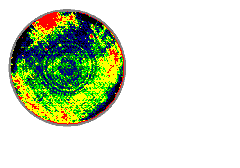
ElectroLYtical Matal Tracer
The heart of the ELYMAT is the electrolytical double cell
![]() .
.
Both sides of the Si-wafer are in contact with deluted HF electrolyte. Illumination with a scanned laser beam generates minority carriers within the silicon wafer near the front surface. Applying a reversed bias across the silicon-electrolyte contact serves as an intrinsic "Schottky-like" contact. Thus photocurrent may be collected
The photogenerated minority carriers may recombine within the bulk, which dependes on their lifetime (respectively their diffusion length L); they may recombine at the wafer surface, which is described by the surface recombination velocity S, or they may be collected as photocurrent. Since the recombination rate depends strongly on the impurity concentration of the silicon, the diffusion length is the most important parameter to determine the quality of silicon.
As described above, the photocurrent is very sensitive to the diffusion length and the ELYMAT serves as a very simple way to measure this Photo Current. Because of the short measuring time, diffusion length maps with high spatial resolusion can be generated. Additionally the ELYMAT allows for a large amount of independent measurements by varying
etc..
Combining this independent measurements, the influence of the bulk and surface recombination activities can be separated to create maps of the bulk diffusion length and surface recombination. Even the depth dependance of the bulk diffusion length can be calculated.
A commercially available ELYMAT is used in the line for wafer monitoring and process control.
Research activities are
depth dependance of diffusion length
multicrystalline silicon for solar cell application